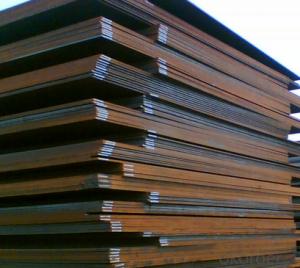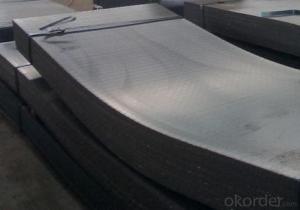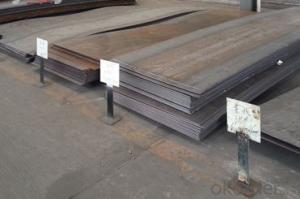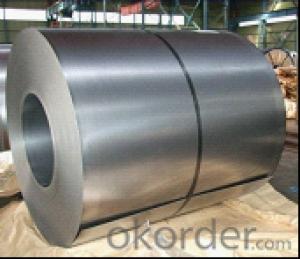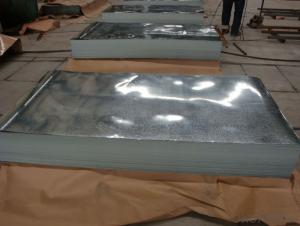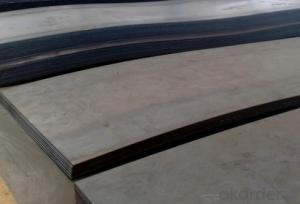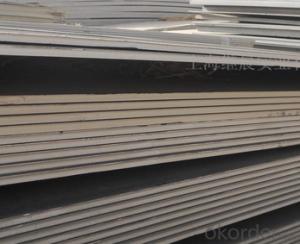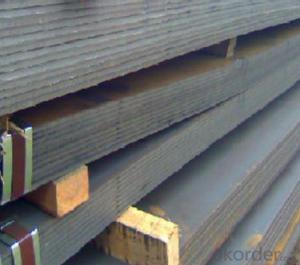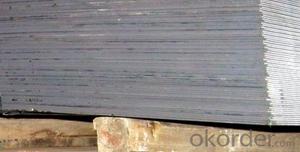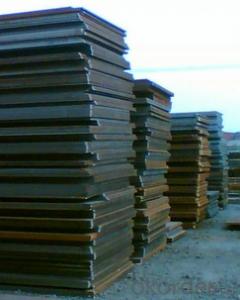Hot Rolled Carbon Steel Plate,Carbon Steel Sheet Q235A CNBM
- Loading Port:
- Qingdao
- Payment Terms:
- TT OR LC
- Min Order Qty:
- 10 pc
- Supply Capability:
- 30 pc/month
OKorder Service Pledge
OKorder Financial Service
You Might Also Like
Quick Details
| Standard: | AISI, ASTM, GB, JIS | Grade: | Q195,Q235,Q345,A36,C45 | Thickness: | 1.0-30MM |
| Model Number: | Q235,Q195,Q345 | ||||
| Type: | Steel Plate | Technique: | Hot Rolled | Surface Treatment: | Coated |
| Application: | Ship Plate | Special Use: | Silicon Steel | Width: | 30-2000mm |
| Length: | as your requirement | standard: | hot rolled | Surface: | Anti-rust oil |
Packaging & Delivery
| Packaging Details: | seaworthy packages or as customers' require |
| Delivery Detail: | within 15 days after the advance payment |
Hot rolled steel plate
1 carbon steel plate 3mm thick General information
| Product name | Type | Specification | Implementation of GB | ||
| thick | wide | long | |||
| Carbon structural steel | Q195,Q215, Q235A,Q235B, Q235C,Q255, Q275 | 4-120 | 1500-4500 | 6000-12000 | GB/T700-2006 |
| Low-alloy structural steel | Q295,Q345A, Q345B,Q2345C | 4-120 | 1500-4500 | 6000-12000 | BG/T1591-1994 |
| Quality carbon structural stee | 30-50 | 4-120 | 1500-4500 | 6000-12000 | BG/T699-1999 |
| Ship steel | CCSA,CCSB | 4-120 | 1500-4500 | 6000-12000 | materials and welding condition |
| CCSAH32,CCSAH36 CCSDH32,CCSDH36 | 4-120 | 1500-4500 | 6000-12000 | materials and welding condition or GB 712-2000 | |
| Boiler steel | 20g,22Mng, 16Mng,19Mng | 4-120 | 1500-4500 | 6000-12000 | GB 713-1997 |
| Pressure vessel steel | 1622Mng,20R, 15MnVR,15MnVNR | 4-120 | 1500-2700 | 6000-12000 | GB 6654-1996 |
| European standard plate
| S235JR,S235J0, S275JR,S275J0, S275JR2,S355JR, S355J0,S355J2 | 4-120 | 1500-4500 | 6000-12000 | EN 10025 |
| Japanese standard plate | SS400,SS400-B | 4-120 | 1500-4500 | 6000-12000 | JIS G3101-2004 |
2 carbon steel plate 3mm thick detail specification
Material:
A283Gr.D/A573Gr.65,A516Gr65,A516Gr70,A284Gr.D
SS400,SS300,CCSB A36,A32,LRA32,LRB,Q235
Q195,Q235,Q345,SS400,ASTM A36,E235B
Thickness: 4mm-120mm
width: 1500mm-4500mm
Length:2-10m ,accordingly
Thickness | 4-120mm |
Width | 1500-4500mm or as custom's request |
Length | 2-12m,as your requirment |
Technique | Cold rolled or hot rolled |
Surface treatment | Bare, galvanized coated or as customer's requirements. |
Standard | ASTM,EN,GB,JIS,GB |
Material | A283Gr.D/A573Gr.65,A516Gr65,A516Gr70,A284Gr.D SS400,SS300,CCSB A36,A32,LRA32,LRB,Q235 Q195,Q235,Q345,SS400,ASTM A36,E235B |
Terms of Payment | L/C or T/T |
Chemical composition | C≤0.004%;Si≤0.030%; Mn ≤0.17%;P≤0.012%; S≤0.010%; Fe balance |
Delivery Detail | within 30days once receive deposite or confirm L/C |
Packing | Standard export packing,or as requirement |
3 carbon steel plate 3mm thick application:
construction,machinery manufacturing, container manufacturing, shipbuilding, bridge construction. Can also be used to manufacture a variety of containers, the furnace shell, furnace plate, bridge and vehicle static steel plate, low alloy steel plate,shipbuilding plate, boiler plate, pressure vessel plate, pattern plate, tractor parts, automobile frame steel plate and welding components
- Q: Can steel sheets be used for fencing or security purposes?
- Yes, steel sheets can be used for fencing or security purposes. Steel sheets provide strong and durable barriers, making them suitable for fencing applications to protect properties or secure areas. Additionally, their robustness and resistance to impact make them ideal for enhancing security by preventing unauthorized access.
- Q: What is the difference between the zinc plated color guide and the profiled steel sheet?
- The difference between the zinc plated color guide plate and the profiled steel plate is as follows:1, plated aluminum plate is pure aluminum 99%, and aluminum zinc is generally divided into 5% zinc plating and 55% aluminum zinc.2, zinc plating in zinc plating on the basis of the development of slowly, and 5% and 55% refers to the aluminum content.
- Q: Can steel sheets be used for interior design purposes?
- Yes, steel sheets can be used for interior design purposes. Steel sheets have a sleek and modern appearance that can add an industrial or contemporary touch to any interior space. They are durable, long-lasting, and resistant to wear and tear, making them suitable for high-traffic areas. Steel sheets can be used in various ways in interior design, such as wall cladding, ceiling panels, room dividers, furniture, countertops, and backsplashes. They can be painted or coated in different finishes to match the desired aesthetic, and can also be shaped or perforated to create unique patterns or textures. Overall, steel sheets offer versatility, strength, and a visually appealing element to interior design projects.
- Q: What are the different sheet metal rolling techniques for steel sheets?
- There are several sheet metal rolling techniques for steel sheets, including hot rolling, cold rolling, and roll bending. Hot rolling involves heating the steel sheet above its recrystallization temperature and then passing it through a series of rollers to reduce its thickness and shape it. Cold rolling, on the other hand, is done at room temperature and involves passing the steel sheet through rollers to achieve the desired thickness and shape. Roll bending is a technique used to curve or bend the steel sheet by passing it through a series of rollers with different diameters. These techniques offer various advantages and are used in different industries depending on the specific requirements of the steel sheet application.
- Q: Can steel sheets be used for decorative purposes?
- Yes, steel sheets can be used for decorative purposes. They can be shaped, cut, and finished in various ways to create unique and visually appealing designs. Steel sheets are often used in architecture, interior design, and artwork, adding a modern and industrial aesthetic to spaces.
- Q: What material can be replaced by 345D steel plate?
- Higher than its level of material of steel plate can replace.Q345D. yield in more than 345 of the steel.D class -20 degree of shock. Can replace the Q370D.Q390D.Q420D.Q460D.Q550D.Q690D., generally in engineering machinery can be higher generation low
- Q: Are the steel sheets resistant to oil or grease?
- Yes, steel sheets are generally resistant to oil and grease.
- Q: Are the steel sheets suitable for architectural cladding?
- Yes, steel sheets are suitable for architectural cladding due to their durability, strength, and versatility in design. Steel sheets can be fabricated into various shapes and sizes, offering flexibility for architectural purposes. Additionally, they provide excellent weather resistance and require minimal maintenance, making them an ideal choice for cladding applications.
- Q: How are steel sheets measured and sized?
- Steel sheets are commonly measured and sized based on their thickness, width, and length. Thickness is usually measured in gauge or millimeters, while width and length are measured in inches or millimeters. The size and dimensions of steel sheets can vary depending on the specific requirements of a project or application.
- Q: Are steel sheets suitable for roofing?
- Yes, steel sheets are suitable for roofing. Steel is a strong and durable material that can withstand various weather conditions, including high winds, heavy rain, and snow. It also offers excellent protection against fire and is resistant to corrosion. Additionally, steel sheets are lightweight, easy to install, and can be designed in different styles and colors to enhance the aesthetic appeal of a building.
Send your message to us
Hot Rolled Carbon Steel Plate,Carbon Steel Sheet Q235A CNBM
- Loading Port:
- Qingdao
- Payment Terms:
- TT OR LC
- Min Order Qty:
- 10 pc
- Supply Capability:
- 30 pc/month
OKorder Service Pledge
OKorder Financial Service
Similar products
Hot products
Hot Searches
Related keywords
